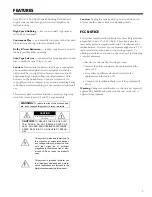
8
CARE
To enjoy your RCA SCT-520 High Speed Dubbing Stereo
Cassette Deck for a long time:
Keep the cassette deck dry. If it gets wet, wipe it dry
immediately.
Use and store the cassette deck only in normal
temperature environments.
Handle the cassette deck gently and carefully. Dont drop
it.
Keep the cassette deck away from dust and dirt.
Wipe the cassette deck with a damp cloth occasionally to
keep it looking new.
Modifying or tampering with the cassette decks internal
components can cause a malfunction and invalidate its
warranty. If your cassette deck is not performing as it should,
take it to your local RadioShack store for assistance.
TAPE TIPS
Tape Selection
For the automatic tape select function to work properly, metal
and chrome (cobalt) tapes must have identification holes.
We do not recommend long-play cassette tapes such as C-120s
because they are thin and can easily tangle.
Restoring Tape Tension and Sound Quality
After you play a cassette tape several times, the tape might
become tightly wound on the reels. This can cause playback
sound quality to deteriorate. To restore the sound quality, fast-
forward the tape from the beginning to the end of one side,
then completely rewind it. Then loosen the tape reels by gently
tapping each side of the cassettes outer shell on a flat surface.
Caution:
Be careful not to damage the cassette when tapping
it. Do not touch the exposed tape or allow any sharp objects
near the cassette.
To prevent the tape from being twisted:
Dont pull the tape out of the upper opening of the cassette
tape.
If the tape is wound loosely inside the cassette, use the
tape deck on fast forward or reverse to tighten the tape.
If a small portion of tape is unwound from the cassette,
tighten the tape using a pencil.
Erasing Tapes
To record over a cassette tape, simply record as usual. The
cassette deck records over the previous recording.
You can quickly erase both sides of a cassette tape using a bulk
tape eraser available at your local RadioShack store.
Note:
If you use metal tape, the recorded sound might not be
erased properly.
Preventing Accidental Erasure
Cassette tapes have two erase-protection tabs one for each
side. When a tab is in place, you can record on that side.
To prevent accidental erasure of a tape recording, use a
screwdriver to remove one or both of the cassette tapes erase-
protection tabs. This prevents
RECORD
from being
pressed.
If you later decide to record on a tape side after you have
removed the erase-protection tab, place a piece of strong
plastic tape over that sides erase-protection hole. Be sure you
cover only the hole originally covered by the erase-protection
tab.
Caution:
Removing the erase-protection tabs does not prevent
a bulk eraser from erasing a cassette tape.
Position Identification Holes
Normal Tape
Chrome (Cobalt) Tape
Erase-Protection Tabs






























